In this article, we are going to show you how to read and write to a file in the C++ programming language by using several examples. To understand C++ file operations like read and write, we must first understand the concept of a stream in C++.
What is a Stream?
A stream is simply a flow of data or characters. There are two types of streams: input streams and output streams. An input stream is used to read the data from an external input device such as a keyboard, while an output stream is used to write data to the external output device such as a monitor. A file can be considered as both an input and output source.
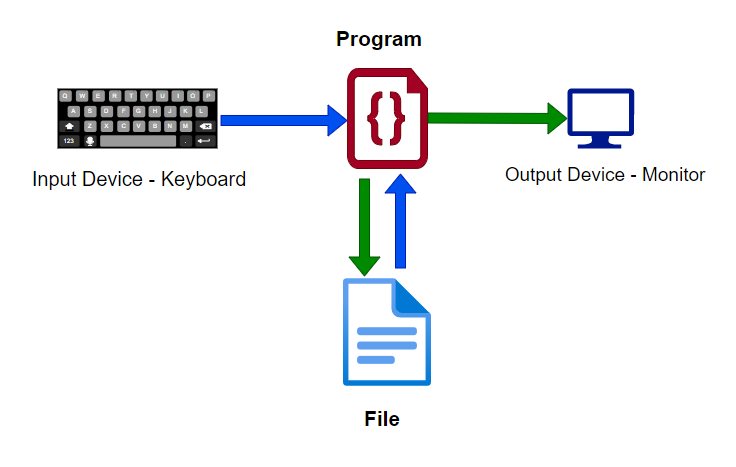
In C++, we use a stream to send or to receive data to or from an external source.
We can use built-in classes to access an input/output stream, i.e., “ios”.
Here is the stream class hierarchy of the C++ programming language:
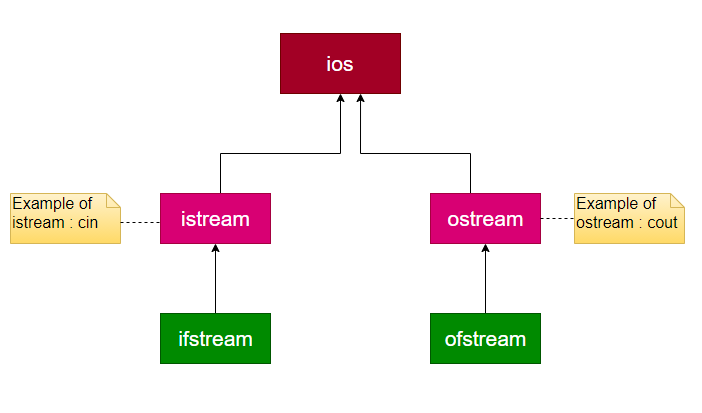
The “cin” and “cout” objects are used to read the data from the keyboard and to display the output on the monitor, respectively. In addition, “ifstream,” which stands for “input file stream,” is used to read a stream of data from a file, and “ofstream,” which stands for “output file stream,” is used to write a stream of data to a file.
The “iostram.h” file contains all the required standard input/output stream classes in the C++ programming language.
Examples
Now that you understand the basics of streams, we will discuss the following examples to help you to better understand file operations in C++:
- Example 1: Open and Close a File
- Example 2: Write to a File
- Example 3: Read from a File
- Example 4: Read and Write to a File
- Example 5: Read and Write to a Binary File
Example 1: Open and Close a File
In this example program, we will demonstrate how to open/create a file and how to close the file in C++. As you can see in the below program, we have included the library required for file operations.
To open and close a file, we need an object of ofstream. Then, to read or write to a file, we have to open the file. We have included the fstream header file at line number-1 so that we can access ofstream class.
We have declared a myFile_Handler as an object of ofstream inside the main function. We can then use the open() function to create an empty file and the close() function to close the file.
using namespace std;
int main()
{
ofstream myFile_Handler;
// File Open
myFile_Handler.open("File_1.txt");
// File Close
myFile_Handler.close();
return 0;
}
Now, we will compile the program and examine the output. As you can see in the output window below, the “File_1.txt” file was created after executing the program. The size of the file is zero since we have not written any content in the file.
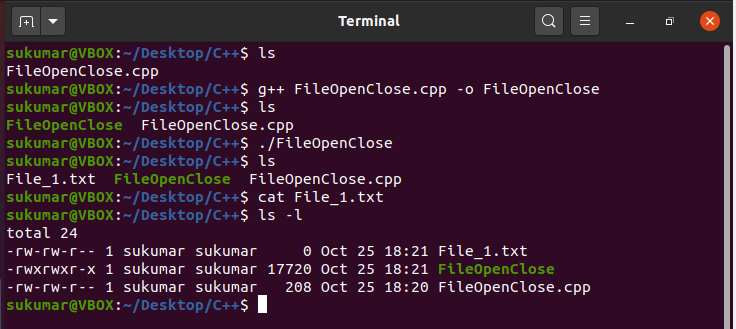
Example 2: Write to a File
In the previous example program, we showed you how to open a file and how to close the file. Now, we will show you how to write something in a file.
We can write to a file using the stream insertion operator, i.e., “<<”. In this program, we have used the file handler and insertion operator to write two lines in the file. The insertion operator (“<<”) indicates that we are inserting the string into the output file stream object.
using namespace std;
int main()
{
ofstream myFile_Handler;
// File Open
myFile_Handler.open("File_1.txt");
// Write to the file
myFile_Handler << "This is a sample test File. " << endl;
myFile_Handler << "This is the second line of the file. " << endl;
// File Close
myFile_Handler.close();
return 0;
}
Now, we will compile the above program and execute it. As you can see below, we have successfully written to the file File_1.txt.

Example 3: Read from a File
In the previous examples, we showed you how to write content to a file. Now, let’s read the content from the file that we created in Example-2 and display the content on the standard output device, i.e., the monitor.
We use the getline() function to read the complete line from the file and then “cout” to print the line on the monitor.
#include <fstream>
#include <string>
using namespace std;
int main()
{
ifstream myFile_Handler;
string myLine;
// File Open in the Read Mode
myFile_Handler.open("File_1.txt");
if(myFile_Handler.is_open())
{
// Keep reading the file
while(getline(myFile_Handler, myLine))
{
// print the line on the standard output
cout << myLine << endl;
}
// File Close
myFile_Handler.close();
}
else
{
cout << "Unable to open the file!";
}
return 0;
}
Now, we will print the content of File_1.txt using the following command: cat File_1.txt. Once we compile and execute the program, it is clear that the output matches the content of the file. Therefore, we have successfully read the file and printed the content of the file to the monitor.
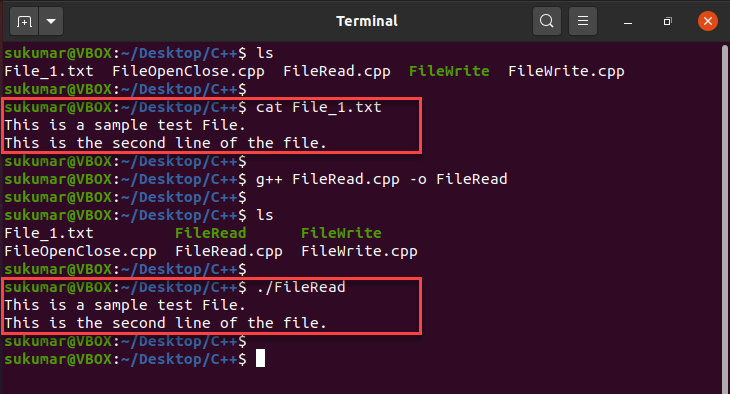
Example 4: Read and Write to a File
So far, we have showed you how to open, read, write, and close a file. In C++, we can also read and write to a file at the same time. To both read and write to a file, we have to get an fstream object and open the file in “ios::in” and “ios::out” mode.
In this example, we first write some content to the file. Then, we read the data from the file and print it to the monitor.
#include <fstream>
#include <string>
using namespace std;
int main()
{
fstream myFile_Handler;
string myLine;
// File Open
myFile_Handler.open("File_1.txt", ios::in | ios::out);
// Check if the file has opened
if(!myFile_Handler)
{
cout << "File did not open!";
exit(1);
}
// Write to the file
myFile_Handler << "1. This is another sample test File. " << endl;
myFile_Handler << "2. This is the second line of the file. " << endl;
myFile_Handler.seekg(ios::beg);
// Read the File
if(myFile_Handler.is_open())
{
// Keep reading the file
while( getline(myFile_Handler, myLine))
{
// print the line on the standard output
cout << myLine << endl;
}
// File Close
myFile_Handler.close();
}
else
{
cout << "Unable to open the file!";
}
myFile_Handler.close();
return 0;
}
Now, we will compile and execute the program.
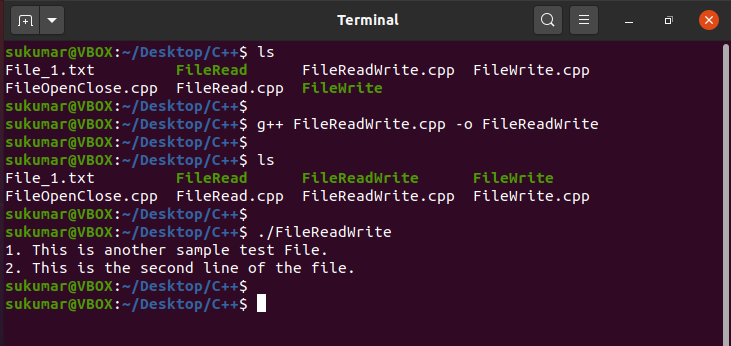
Example 5: Read and Write to a Binary File
In this example, we are going to declare a class and then write the object to a binary file. To simplify this example, we have declared the Employee class with a public variable emp_id. Then, we will read the binary file and print the output to the monitor.
#include <fstream>
using namespace std;
class Employee
{
public:
int emp_id;
};
int main()
{
ofstream binOutFile_Handler;
ifstream binInFile_Handler;
Employee empObj_W, empObj_R;
// File Open
binOutFile_Handler.open("Employee.dat", ios::out | ios::binary);
// Check if the file has opened
if(!binOutFile_Handler)
{
cout << "File did not open!";
exit(1);
}
// Initialize empObj_W
empObj_W.emp_id = 1512;
// Write to the file
binOutFile_Handler.write((char *) &empObj_W, sizeof(Employee));
binOutFile_Handler.close();
if(!binOutFile_Handler.good())
{
cout << "Error occured during writing the binary file!" << endl;
exit(2);
}
// Now, let's read the employee.dat file
binInFile_Handler.open("Employee.dat", ios::in | ios::binary);
// Check if the file has opened
if(!binInFile_Handler)
{
cout << "File did not open!";
exit(3);
}
// Read the content of the binary file
binInFile_Handler.read((char *) &empObj_R, sizeof(Employee));
binInFile_Handler.close();
if(!binInFile_Handler.good())
{
cout << "Error occured during reading the binary file!" << endl;
exit(4);
}
// Print the output of empObj_R
cout << "Details of the Employee : " << endl;
cout << "Employee ID : " << empObj_R.emp_id << endl;
return 0;
}

Conclusion
Files are mainly used to store the data, and they play an important role in real-world programming. In this article, we showed you how to use various file operations with the C++ programming language by working through several examples. Furthermore, we showed you how to read and write data into both text files and binary files.
from Linux Hint https://ift.tt/38uSt7r




0 Comments